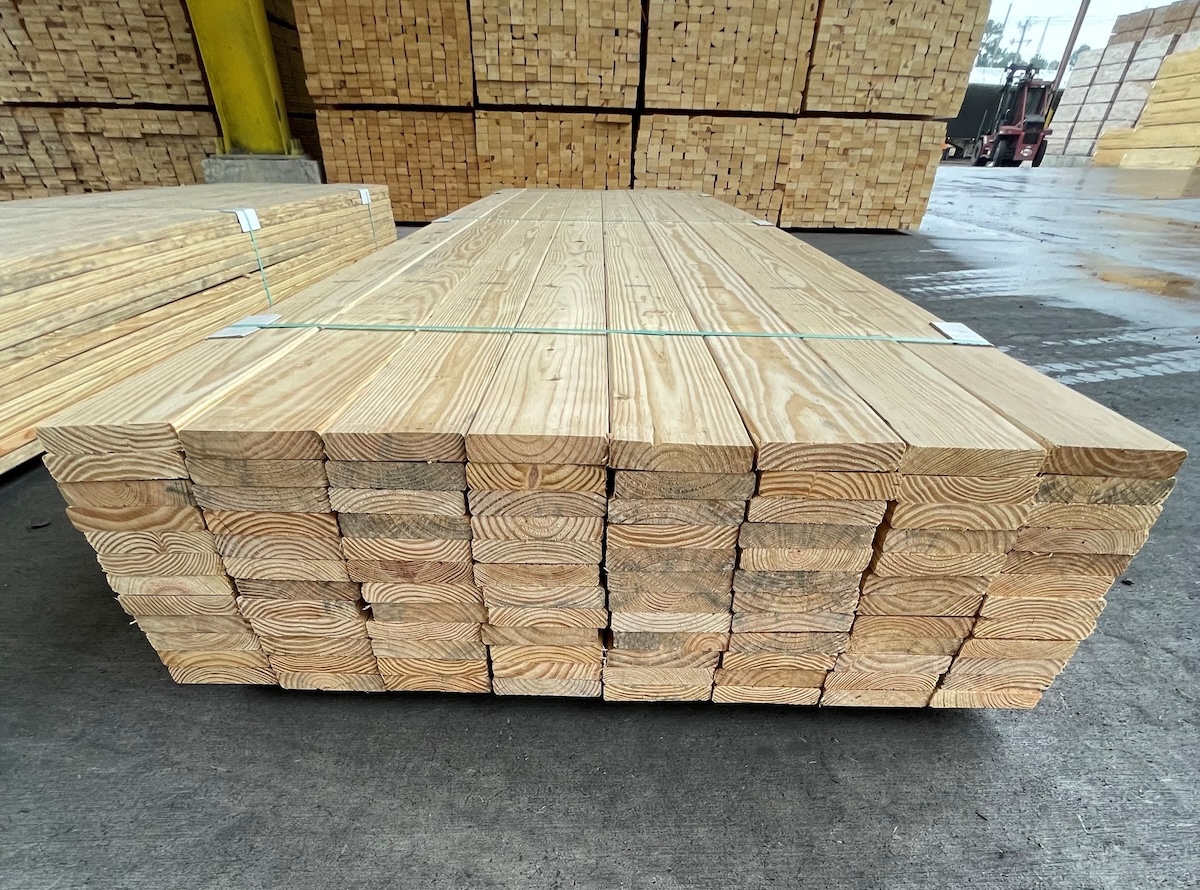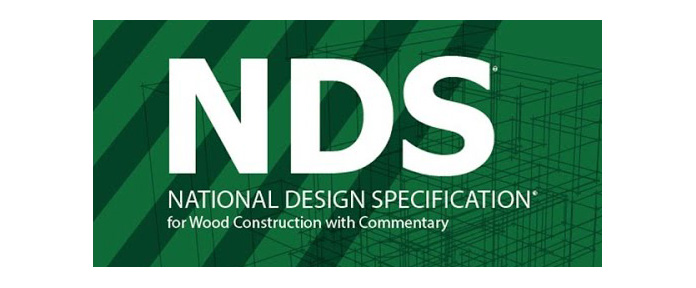Vertical Use Finger Joint Studs
Code Acceptance & Quality Assurance
Code Acceptance – For builders and code officials, the use of finger joint lumber is accepted for building design in the United States within the International Building Code (IBC). Section 2303.1.1.2 of the IBC states the following: “Approved end-jointed lumber is permitted to be used interchangeably with solid-sawn members of the same species and grade.” Furthermore, the 2018 International Building Code references the National Design Specification for Wood Construction (NDS), published by the American Forest & Paper Association, for the structural analysis and design of wood-based structures. Section 4.1.6 of the 2018 NDS states the following: “Reference design values for sawn lumber are applicable to structural end-jointed or edge-glued lumber of the same species and grade. Types of Joints STUD USE ONLY. A Stud Use Only stamp signifies jointed lumber with a primary purpose of resisting compression loads. Also labeled VERTICAL USE ONLY, the joints are usually 3/8” to 5/8” long and may have blunt tips on the fingers. While the adhesives used in this lumber are typically water resistant, they are only certified for interior use (including both interior and exterior walls within the building envelope).
Quality Assurance – Independent third-party verification is provided on all finger joint studs. Strength and bonding tests are administered many times daily to meet and exceed the requirements of the American Lumber Standards Committee. (A.L.S.C.)
- Bending strength
- Shear strength
- Joint stability
- Pressure vacuum treatment
Western Spruce Pine Fir DfirN #2 / Stud & Premium Finger Joint Studs
Superior Performance Vertical Use Studs “Framers’ Preference” – Straight, Strong, Stable
There are several advantages of framing with finger joint studs. Product characteristics straight, strong, and stable, ensuring builders have a good nailing edge as well as being cost effective with minimal cull or call backs.
Each stud has an average of 5-7 joints per 9’ board, providing a straight, strong, and stable product.
Manufactured in Northern British Columbia.
Special Products Standard for Fingerjoined “Vertical Stud Use Only” Lumber
Notes: Project managers can apply to receive points towards green builds. NLGA “Vertical Use” finger joint studs are used interchangeably with “solid sawn studs,” same size, grade, and species.
HRA – Heat Resistant Adhesive
| Species | Width | Length | Grade |
|---|---|---|---|
| SPF DfirN | 2 x 3 | 84″ – 144″ | Stud & #2 Premium |
| SPF DfirN | 2 x 4, 2 x 6 | 84″ – 144″ | Stud & #2 |
| SPF DfirN | 2 x 4, 2 x 6 | 84″ – 144″ | Stud & #2 Premium |
| Packaging: | Paper Wrapped | ||
| Shipments: | Truck or Rail |
Note: Parallel Wood Products Ltd. stamp will contain HfirN



Southern Yellow Pine (SYP) #2 Finger Joint Studs
Superior Performance Vertical Use Studs “Framers’ Preference” – Straight, Strong, Stable
There are several advantages of framing with finger joint studs. Product characteristics straight, strong, and stable, ensuring builders have a good nailing edge as well as being cost-effective with minimal cull or call backs.
Each stud has an average of 5-7 joints per 9’ board, providing a straight, strong, and stable product.
Manufactured in Boaz, Alabama.
Structural Finger Jointed Lumber
Notes: Project managers can apply to receive points towards green builds. TP “Vertical Use” is used interchangeably with “Solid Sawn Studs,” same size, grade, and species.
| Species | Width | Length | Grade |
|---|---|---|---|
| SYP | 2 x 3 | 84″ – 144″ | #2 |
| SYP | 2 x 4 | 84″ – 144″ | #2 |
| SYP | 2 x 6 | 84″ – 144″ | #2 |
| Packaging: | Bag upon request | ||
| Shipments: | Truck Tarped | ||
| Services: | Dado Available | ||
| Treatment: | Mold Inhibitor |
HRA – Heat Resistant Adhesive



Southern Yellow Pine (SYP) Dimensional Products
Manufacturing Consistent Quality Dimension Products & Decking for the Building Industry
Our high quality Southern Yellow Pine offers density and strength use for framing, treating, truss manufacturing, manufactured housing, and general construction.
| Species | Width | Length | Grade |
|---|---|---|---|
| SYP | 2 x 4 | 8′ – 16′ | MSR 2400, #1, #2, #3, #4 |
| SYP | 2 x 6 | 8′ – 16′ | MSR 2400, #1, #2, #3, #4 |
| SYP | 2 x 8 | 8′ – 16′ | MSR 2400, #1, #2, #3, #4 |
| SYP | 2 x 10 | 8′ – 16′ | MSR 2400, #1, #2, #3, #4 |
| SYP | 2 x 12 | 8′ – 16′ | MSR 2400, #1, #2, #3, #4 |
| Packaging: | Bagged available upon request | ||
| Shipments: | Truck, or Rail Delivery | ||
| Packaging: | PET Available |
Note: MSR 2400 pulled #1 wane rule. This provides our customers with an exceptional product.



Southern Yellow Pine Decking
Southern Yellow Pine decking is known for its natural beauty and strength and is an excellent choice for any size deck. Southern Yellow Pine is incredibly strong and weather resilient, its porous surface lends itself well to stain and paint treatments.
| Species | Width | Length | Grade |
|---|---|---|---|
| SYP | 5/4 x 6 | 8′ – 16′ | Premium, Standard, Construction Grade |
| Packaging: | Wrap available upon request | ||
| Shipments: | Truck or Rail |



What are Finger Joint Studs?
Finger joint studs are manufactured by taking short blocks of kiln-dried lumber, scanning and remove defect(s), cutting a “finger” profile into each end, applying the appropriate adhesive, and machine-pressing the pieces together to make a longer piece of lumber. Finger joint technology allows the softwood lumber industry to recover these blocks of premium grade lumber that in the past would have been discarded.
Finger joint studs are subject to stringent quality control requirements including regular in-plant testing to assure strong reliable joints. Manufacturers sample production several times each shift and test for bond strength and adhesive durability. Structural finger joints must exhibit strength values more than twice the design value for the grade.
Myths and Facts About Finger Joint Studs
Canadian finger joint vertical-use studs have been in production for over twenty-five years and are widely accepted throughout North America. Learn the facts here:
Myth: Finger joint studs are weaker than solid lumber.
Fact: Finger joint studs are actually stronger than solid sawn stud lumber. The process of joining shorter pieces of lumber together creates a product that is more stable and resistant to warping, twisting, and splitting. The joints are break tested ensuring their strength.
Myth: Finger joint studs are made from scrap wood.
Fact: While it is true that finger joint studs are made from shorter pieces of lumber, these pieces are not considered scrap wood. In fact, the pieces used to make finger joint studs are carefully selected and graded for their strength and stability. Only the highest quality pieces are used to make finger joint studs.
Myth: Finger joint studs are not as attractive as solid lumber.
Fact: Finger joint studs can be just as attractive as solid stud lumber. The process of joining shorter pieces of lumber together creates a product with a more uniform appearance and superior performance which is desirable by framers in wall applications. Additionally, finger joint studs can be stained or painted to match the surrounding decor.
Myth: Finger joint studs are not environmentally friendly.
Fact: Finger joint studs are actually a more environmentally friendly option than solid lumber. By using shorter pieces of lumber, finger joint studs reduce waste and make use of materials that might otherwise be discarded. Additionally, finger joint studs are often made from sustainably harvested wood, which means that it is produced in a way that is mindful of the environment.
Myth: Finger joint studs are difficult to work with.
Fact: Finger joint studs are actually easier to work with than solid lumber in many cases. Finger joint studs are straight, more stable, and resistant to warping. They are less likely to split or crack during installation, which can save time and reduce waste on job sites.
In conclusion, finger joint studs are a strong, attractive, and environmentally friendly option for construction projects. Despite the myths and misconceptions surrounding this type of lumber, the facts show that it is a cost-effective and easy-to-work-with option that can withstand the stresses of construction. By understanding the facts about finger joint studs, builders and contractors can make informed decisions about the materials they use, ensuring that their projects are both successful and sustainable.










